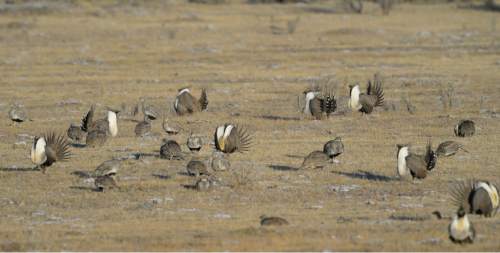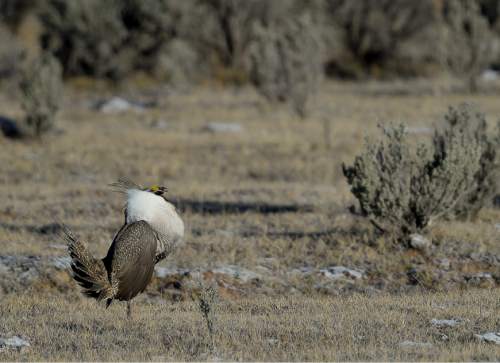This is an archived article that was published on sltrib.com in 2015, and information in the article may be outdated. It is provided only for personal research purposes and may not be reprinted.
Amid all the development, drought and drilling, it is usually a natural phenomenon that most endangers the greater sage grouse in the Great Basin states.
U.S. Department of the Interior officials claim scientists and wildlife experts have identified rangeland fire as the greatest threat to the survival of the bird in parts of Utah, Idaho, Nevada, Oregon and California.
Interior Secretary Sally Jewell released a final report Tuesday with strategies to address the threat of wildfires to sagebrush ecosystems during a press conference in Boise.
"We now have a fully integrated strategy among federal, state, tribal and community partners that provides a set of actions to take now and in the future to fight rangeland fires across the West," Jewell said. "This roadmap takes a comprehensive and scientific approach to protect against some of the most intense wildfires that are damaging the American West's productive rangelands and sagebrush landscapes."
The report provides a long-term plan to deal with rangeland fire — including preventive burns, eradication of fire-feeding invasive plants and more aggressive wildfire suppression.
Officials report fires in the Great Basin have increased in size and intensity over recent years.
Lands ravaged by fire are now soon covered by nonnative plants such as cheatgrass. The invasive plants provide little food or cover for native wildlife and prevent native plant species from taking root. The non-native vegetation also creates more intense and more frequent wildfires.
Sagebrush steppe habitat is home to greater sage grouse in 11 states, but the sagebrush sea also has been identified as being important to more than 300 species of plants and animals.
"People can look out [at sagebrush lands] and say there is nothing there," Jewell said. "But 350 species need that environment."
A multi-state campaign to protect and restore western sagebrush habitat is underway as U.S. Fish and Wildlife Service managers ponder whether or not to place the greater sage grouse on the Endangered Species List. A decision is required by the end of September.
Wildfire was identified as a serious threat to sage grouse when Utah Gov. Gary Herbert signed an executive order making protecting sage grouse a priority.
Kathleen Clarke, director of the Utah Public Lands Policy Coordinating Office, said firefighting plans would take sage grouse habitat into account.
"Sage grouse will be a priority right below human life and property during fire management," Clarke said at the announcement.
The strategies for dealing with the threat of wildfire in the Great Basin include:
• Developing fire response plans for federal wildland firefighters that prioritize protection of rural communities and landscapes most threatened by rangeland fire and invasive species.
• Targeting funding to high-value rangelands based on their relative resilience and resistance to disturbance.
• Using maps and technology to get information about priority areas for fire suppression into the hands of fire managers and firefighters on the ground.
• Developing new tools to fight the spread of invasive species.
• Directing better coordination between resource managers and firefighters to ensure that fuelbreaks, suppression efforts and restoration projects provide the greatest benefit to communities and wildlife.
• Increasing the collection and use of native seeds and plants to restore fire-impacted lands and accelerating revegetation projects.
• Planning fire prevention and restoration efforts at a landscape level to speed up planning and get projects underway.
• Identifying opportunities to enhance tribal, state and local fire management capabilities and coordination in priority sage-steppe areas.







